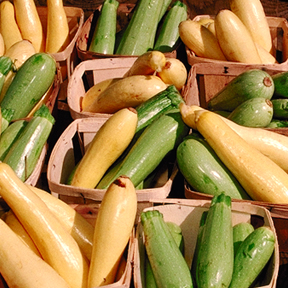Summer Squash
| Summer Squash | |
|---|---|
 | |
| Binomial: | Cucurbita pepo |
| Light requirements: | Full sun to light shade |
| Soil requirements: | Rich |
| Transplant: | Sow 2 seeds per 3-4 inch pot |
| Plant spacing: | 18 to 36 inch (45-90 cm) centers |
The Summer Squashes are a group of plants in the species Cucurbita pepo, which are grown for their fruits. They come in many varieties among several major groups including: Yellow Summer, Zucchini, Crookneck, and Cousa. While there are some differences in flavor between these groups, their cultivation is essentially the same.
Summer squashes grow on short vines, appearing bushy in the field. The leaves are large, palmately lobed, and usually variegated with white or pale green.
These plants are highly productive, particularly when the fruits are harvested while young: gardeners growing these plants often have plenty of produce to share with friends. The flowers are also edible and both male and female flowers are harvested for this purpose.
Growing Conditions
[edit | edit source]Summer Squashes grow in full sun or light shade. They require a rich soil for good fruit production.
Planting
[edit | edit source]Direct Seed
[edit | edit source]Summer Squashes grow easily from seeds sown in situ. Plants should be thinned to 18 to 36 inch (45-90 cm) centers. Seeds can be sown as soon as the soil warms up.
Seedlings in Containers
[edit | edit source]For growing transplants, sow 2 seeds per 3 or 4 inch pot. Seedlings grow quickly in warm weather, so should not be started before the planting area is prepared.
Transplanting
[edit | edit source]Transplants should not be broken up or have their roots cut unless severely rootbound. Soil may be mounded up to the lowest set of leaves.
Maintenance
[edit | edit source]Early Spring
[edit | edit source]Enrich planting area with composts, but not with manures, as too much nitrogen may reduce the fruiting.
Summer
[edit | edit source]Pick regularly to avoid over-ripening and encourage further fruit set. If small fruits appear wrinkled or discolored, remove them (they may not have been pollenated). Monitor for Squash vine borer. Hill up composts to the lowest leaf set, adding more as the lower leaves yellow off (the small early leaves will die off naturally as the upper leaves shade them out). This provides both nutrients and some protection for SVB. Keep the growing area free of weeds, but maintain nectar sources nearby to ensure an ample supply of pollenating insects.
Fall Cleanup
[edit | edit source]Burn borer-infected vines, and till area to disturb any coccoons. If rotation is not possible, use a winter cover crop such as rye, vetch, or pea to enrich the soil.
Harvesting
[edit | edit source]Cut the stems with a sharp knife. Summer squashes are best harvested well before the fruit matures, as the seeds become hardened in large fruit. Fruits can be harvested even before the flowers fully open if desired.
Propagation
[edit | edit source]By seed, from the mature fruits. If collecting seed, allow the most productive plants to produce a single mature fruit towards the end of the season, picking it after the plant is frost-killed.
Pests and Diseases
[edit | edit source]Fungal Diseases
[edit | edit source]Powdery Mildew
Viral diseases
[edit | edit source]Arthropod Pests
[edit | edit source]Vertebrate Pests
[edit | edit source]Varieties
[edit | edit source]Yellow Summer Squashes
[edit | edit source]- Multipik
- Sunray
Cousa Squashes
[edit | edit source]- Magda
Zucchinis
[edit | edit source]- Cashflow
Crooknecks
[edit | edit source]References
[edit | edit source]
